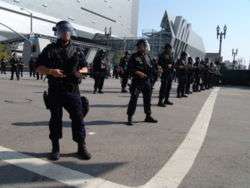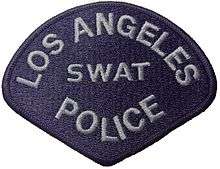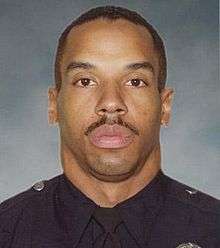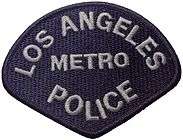LAPD Metropolitan Division
| Los Angeles Police Department Metropolitan Division | |
|---|---|
| Common name | Metro Division |
| Abbreviation | LAPD |
|
The shoulder patch of the LAPD Metropolitan Division. | |
| Motto | "To Protect and to Serve" |
| Agency overview | |
| Formed | 1933 |
| Legal personality | Governmental: Government agency |
| Jurisdictional structure | |
| Operations jurisdiction* | City of Los Angeles in the state of California, United States |
| Size | 498 sq mi (1,290 km²) |
| Population | 3.8 million |
| Legal jurisdiction | City of Los Angeles, California |
| General nature |
|
| Operational structure | |
| Headquarters |
251 East 6th Street Los Angeles, California |
| Police Officers | Approx. 350 |
| Unsworn members | Approx. 15 |
| Agency executives |
|
| Parent agency | Los Angeles Police Department |
| Platoons |
6
|
| Website | |
| Metropolitan Division - Los Angeles Police Department | |
| Footnotes | |
| * Divisional agency: Division of the country, over which the agency has usual operational jurisdiction. | |
The Los Angeles Police Department Metropolitan Division, also known as Metro, is an elite division within the Los Angeles Police Department (LAPD). The Metro Division, which also contains LAPD's Special Weapons and Tactics (SWAT) team, contains seven platoons of specially-trained police officers. It is tasked with numerous crime-fighting duties including solving major crimes, surveillance, providing counter-terrorism details and attending high-risk barricaded situations, such as a hostage situation.
History
Metro Division developed from a compact, mobile crime-fighting team formed by Chief James E. Davis in 1933. Named the Reserve Unit, it was formed to work throughout Los Angeles to specifically suppress criminal activity.[2] By 1968 the unit was expanded from 70 officers to approximately 200 officers. In 1997, following the North Hollywood bank robbery, numbers were increased to approximately 350 sworn officers and 16 civilian support personnel.[2]
The Reserve Unit was originally based out of Room 114 at Parker Center, the LAPD's headquarters. The code number 114 is used today to refer to the Metropolitan Division and its headquarters. Metro is now based at LAPD's Central Facilities Building.[2]
Objectives
The Metropolitan Division's primary responsibility (other than SWAT) is to provide support to the LAPD’s community-based policing efforts by deploying additional crime suppression resources throughout Los Angeles when needed.[2] Assignments of both SWAT and Metro Division as a whole include:
- counter-terrorism
- providing assistance to investigators in solving major crimes
- responding to high-risk barricaded situations
- stakeouts
- security details
- serving warrants
- uniformed crime suppression details (crowd control)
Organization
There are seven field platoons (A, B, C, D, E, G, and K-9 Platoons) an operations platoon (M Platoon) and a dignitary protection platoon (H Platoon); all platoons are supervised by a Lieutenant. The Operations Platoon performs the administrative and support functions. “A, B, C, and G" Platoons are primarily responsible for crime suppression. Special Weapons and Tactics (SWAT), “D” Platoon personnel, respond to emergency situations involving barricaded suspects or hostages. “K-9” Platoon and “E” (Mounted Unit) Platoon makes up the remainder of the Division. The Division also maintains a doctor, crisis negotiators and other specialists in weaponry, computer science, and audio-visual technology.
A, B, C, E, H, G and K-9 Platoons have gradually been issued the HK 416 rifle to be placed alongside the M4 Carbine.
M Platoon (Command, administration, and support)
"M" platoon serves as the command and administrative section and also provides the support function for the Division. In addition to the administrative duties, they coordinate Metro’s many tactical firearms training programs, ensure compliance with state-mandated (POST) training, and maintain the extensive armory of specialized weapons. Additionally, the Crime Analysis and Deployment Detail utilizes automated repressible crime information citywide to determine Metro deployment in identified high-risk areas. In addition, this platoon is in charge of the armory that maintains all of Metro’s equipment. This includes millions of dollars worth of specialized vehicles, weapons, ammunition and other specialized tools of Metro’s trade.
A, B, C, and G Platoons (Crime suppression)

"A, B, C, and G" platoons are tasked with crowd control, riot control, tactical support elements, protection details, counter-assault teams, and crime suppression. Their most active function is maintaining selective enforcement details in high frequency crime areas and targeting repeat offenders and criminal predators. Particular efforts are directed to the suppression of burglary, robbery, auto theft, and attacking violent irrepressible crime. A, B, C, and G Platoons often serve high risk search warrants. During most of the protection details and high profile events within the city, these platoons deploy heavily armed tactical units for added security.
D Platoon (SWAT)
D Platoon is the Special Weapons and Tactics (SWAT) team of the LAPD, provides the Department with 24-hour coverage necessary for immediate response to barricaded suspects, snipers, crisis and hostage negotiations, potential suicide-related situations, and other high-risk incidents. Rapid deployment, surprise, extensive tactics training and thorough planning are all parts of successful SWAT operations. SWAT currently operates the Lenco B.E.A.R.[3] and two smaller Lenco BearCat and one MedCat[4] armored rescue vehicles.[5][6]
E Platoon (Mounted unit)
The "E" Platoon serves as both the LAPD's mounted police unit and the reserve unit of the Special Operations Bureau. The "E" platoon began as a volunteer/reserve officer program and was formally integrated into the Department in 1988. The platoon currently has 32 horses and is located in a state-of-the-art Ahmanson Equestrian Facility. Officers and their horses deploy on City streets or during special events and add to the Department’s professional image. Beyond that, the Mounted Platoon performs crime suppression duties and responds to crowd control incidents.
H Platoon (Dignitary Protection)
H Platoon is responsible for the security teams that protect the Mayor, Chief of Police and City Attorney.
Canine (K-9) Platoon
The Canine Platoon, or "K-9" Platoon deploys highly trained dog handlers and their canine partners to conduct searches and apprehend felony suspects throughout the Los Angeles area. K-9 personnel are deployed around-the-clock, seven days a week. They are available to assist any LAPD department with searches for felony suspects. Two K-9 officers have also been trained in search and rescue operations using dogs.
In 1990, the Liberty Award was created for police dogs who are killed or seriously injured in the line of duty. The medal, which is named after Liberty, a Metropolitan Division K-9 who was shot and killed in the line of duty, has only been awarded once in its history. Liberty's handler received the Medal of Valor for the same incident.[7]
History of LAPD SWAT

While not the first to use specially trained units, the LAPD was the first to form a specific SWAT team, and originally created the term, "Special Weapons And Tactics". John Nelson was the LAPD officer who came up with the idea to form a specially trained and equipped unit in the LAPD, intended to respond to and manage critical situations involving shootings while minimizing police casualties. In 1967, Nelson's CO, then-Inspector Daryl F. Gates approved this idea, and he formed a small select group of volunteer officers. This first SWAT unit initially consisted of fifteen teams of four men each, for a total staff of sixty. These officers were given special status and benefits. They were required to attend special monthly training. This unit also served as a security unit for police facilities during times of civil unrest.[8]
In 1971, SWAT personnel were assigned on a full-time basis to Metropolitan Division to respond to continuing action by subversive groups, the rising crime rate and the continuing difficulty of mustering a team response in a timely manner. Metropolitan Division, which had a long-established reputation as the tactical unit of the Department, was reorganized into 6 units: "A", "B", "C", "D", "E", and "K-9" Platoons.[8] The Special Weapons And Tactics Unit was given the designation of "D" Platoon, and at the same time formally adopted the acronym SWAT[8]
The first significant deployment of LAPD's SWAT unit was on December 9, 1969, in a four-hour confrontation with members of the Black Panthers. The Panthers eventually surrendered, with three Panthers and three officers being injured. By 1974, there was a general acceptance of SWAT as a resource for the city and county of Los Angeles.
On April 14, 2015, Mayor Eric Garcetti announced during the State of the City address that he would add more than 200 officers to the Metro division in an effort to control the crime rate which dramatically increased the year previously.[9]
Famous incidents
SLA confrontation
On the afternoon of May 17, 1974, elements of a group which called itself the Symbionese Liberation Army (SLA), a group of heavily armed leftists, barricaded themselves in a residence on East 54th Street at Compton Avenue in Los Angeles. Coverage of the siege was broadcast to millions via television and radio and featured in the world press for days after. Negotiations were opened with the barricaded suspects on numerous occasions, both prior to and after the introduction of tear gas. Police units did not fire until the SLA had fired several volleys of semi-automatic and fully automatic gunfire at them. In spite of the 3,772 rounds fired by the SLA, no civilians or police officers sustained injury from gunfire.[10]
During the gun battle, a fire erupted inside the residence. The cause of the fire is officially unknown, although police sources speculated that an errant round ignited one of the suspects' Molotov cocktails. Others suspect that the repeated use of tear gas grenades, which function by burning chemicals at high temperatures, started the structure fire.[10] All six of the suspects suffered multiple gunshot wounds and perished in the ensuing blaze.[10]
By the time of the SLA shoot-out, SWAT teams had reorganized into six 10-man teams, each team consisting of two five-man units, called elements.[8] An element consisted of an element leader, two assaulters, a scout, and a rear-guard. The normal complement of weapons was a sniper rifle (apparently a .243-caliber bolt-action, judging from the ordnance expended by officers at the shootout), two .223-caliber semi-automatic rifles, and two shotguns. SWAT officers also carried their service revolvers in shoulder holsters. The normal gear issued them included a first aid kit, gloves, and a gas mask. In fact it was a change just to have police armed with semi-automatic rifles, at a time when officers were usually issued six-shot revolvers and shotguns. The encounter with the heavily armed Symbionese Liberation Army, however, sparked a trend towards SWAT teams being issued body armor and fully automatic weapons of various types.
1997 North Hollywood shootout
The North Hollywood shootout was an armed confrontation between two heavily armed and armored bank robbers, Larry Eugene Phillips, Jr. and Emil Matasareanu, and both SWAT and patrol officers in North Hollywood, Los Angeles, California on February 28, 1997. It began when responding North Hollywood Division patrol officers engaged Phillips and Matasareanu leaving a bank which the two men had just robbed. Eleven officers and seven civilians sustained injuries before both robbers were killed.[11] Phillips and Matasareanu had robbed several banks prior to their attempt in North Hollywood and were notorious for their heavy armament, which included automatic rifles. LAPD patrol officers, like most at the time, were typically armed with a 9mm Beretta on their person, with a 12-gauge shotgun available in their cars (only SWAT officers were regularly equipped with automatic weapons). Phillips and Matasareanu carried fully automatic AK-47 rifles, with ammunition capable of penetrating regular police body armor, and wore full body armor of their own. Since most handgun calibers cannot penetrate body armor, patrol officers had a significant disadvantage until LAPD SWAT arrived with equivalent firepower and body armor;[11] they also appropriated several semi-automatic rifles from a nearby firearms dealer to help even the odds, though by the time this began to happen, SWAT had already arrived.[11] The incident sparked debate on the appropriate firepower for patrol officers to have available in similar situations in the future.[12]
First officer fatality
| Randal David Simmons | |
|---|---|
 Randal Simmons | |
| Born |
July 22, 1956 Los Angeles, California |
| Died |
February 7, 2008 (aged 51) Winnetka, California |
| Other names | Randy |
|
Police career | |
| Department | Los Angeles Police Department |
| Years of service | 27 |
| Rank |
Sworn in as an officer - 1981 |
Randal "Randy" David Simmons (July 22, 1956 – February 7, 2008) was the first member of the Los Angeles Police Department's SWAT team to be killed in the line of duty in its 40-year history (although an officer died in a training accident in 1998).[13] He was shot and killed in Winnetka, California during a standoff with a barricaded suspect. He was among five deaths, including three civilians and the suspect, that day. Another SWAT officer, James Veenstra, was also injured in the same incident.
Simmon's funeral, which was attended by nearly 10,000 mourners including law enforcement personnel from all over the world, was the largest police officer funeral in both Los Angeles and United States history.[14] Simmons, who was a 27-year LAPD veteran, had been with SWAT for more than 20 years.[15]
To honor his legacy, the Metropolitan Division Randal Simmons Explorer Post 114 was named and dedicated after his death to continue his youth outreach work.
Media representations of LAPD SWAT
The SWAT police unit quickly became well known in the short-lived television series SWAT in the 1970s. In 2003, the film adaptation of the series starred Samuel L. Jackson, Colin Farrell and LL Cool J, and was directed by Clark Johnson. The film was a success at the box office.[16]
The SWAT series of computer games, created by Sierra Entertainment and developed by Vivendi Universal and Irrational Games, started off as an interactive movie follow up of the Police Quest series, which was narrated by retired LAPD Chief Daryl Gates, and was continued as a real-time strategy game, and then three first person shooters similar to the Rainbow Six series. All but the most recent one, SWAT 4, have featured endorsements from the LAPD.
Controversial deployments
The MacArthur Park rallies were two May Day rallies demanding amnesty for illegal immigrants [17][18][19][20] which occurred on May 1, 2007, at MacArthur Park. Six hundred police officers, including Metropolitan Division officers from “B” and “C” Platoons, were tasked with crowd control. When protesters began blocking city streets, the crowd was ordered to disperse; the orders were given in English to a crowd of mostly Spanish speaking demonstrators.[21] A significant portion of the crowd did disperse on these commands while police officers formed a line and advanced slowly to clear the area. The officers proceeded about 50 feet at a time, allowing those complying with the dispersal order to retreat.[22] Officers were attacked with plastic bottles, rocks and other projectiles, and responded with tear gas, rubber bullets, and batons, with approximately 146 foam-rubber projectiles fired.[23] Twenty-seven marchers and nine members of the media were injured, five people were arrested,[24] and at least fifty civilians filed complaints with the LAPD regarding mistreatment by officers. A $13 million settlement was paid over allegations of civil rights violations.[25] Seventeen officers and two sergeants from the Metropolitan Division would eventually be disciplined for their actions.[26]
References
- ↑ "News Release, November 23, 2009". LAPD (eff. January 3, 2010). Retrieved 2009-11-27.
- 1 2 3 4 "History of the Metro Division - Los Angeles Police Department". Lapdonline.org. Retrieved 2016-04-29.
- ↑ "Bear 10 photo" (JPG). Code22high.com. Retrieved 2016-04-29.
- ↑ "Medcat-LAPD's One-of-a-Kind Rescue Vehicle - Los Angeles Police Department". Lapdonline.org. Retrieved 2016-04-29.
- ↑ "20101205-M4T-LAPD-SWAT-R4-003 | Flickr - Photo Sharing!". Flickr. 2010-12-05. Retrieved 2016-04-29.
- ↑ "Archived copy". Archived from the original on March 15, 2012. Retrieved September 5, 2011.
- ↑ "libertylib.com". Libertylib.com. Retrieved 2016-04-29.
- 1 2 3 4 "History of S.W.A.T.". Retrieved 2008-07-05.
- ↑ "State of City: Garcetti focuses on public safety; wants Uber, Lyft at airport". Los Angeles Times. 2015-04-14. Retrieved 2016-04-29.
- 1 2 3 "SLA: The shootout". Courttv.com. October 12, 2001. Retrieved 2007-08-18.
Perry and Hall exited the house, but were shot by officers who concluded they were trying to kill police rather than surrender.
- 1 2 3 Shootout!; The History Channel; Viewed July 8, 2008.
- ↑ Cynthia Fuchs (2003-06-01). "44 Minutes: The North Hollywood Shootout". PopMatters. Retrieved 2007-09-29.
The legal and cultural fallout of the crime had to do with just how much firepower the cops should be carrying, if outlaws find it so easy to purchase AK-47s at gun shows.
- ↑ Richard Winton; Molly Hennessy-Fiske; Andrew Blankstein. "Sniper shot gunman as he tried to flee.". Los Angeles Times. Archived from the original on February 8, 2008. Retrieved February 7, 2008.
- ↑ Rubin, Joel; Paloma Esquivel (February 16, 2008). "Thousands pay tribute to officer who touched—and saved—lives". Los Angeles Times.
Los Angeles Police Officer Randal Simmons was remembered in a tearful, three-hour ceremony attended by nearly 10,000 people, most of them police and other law enforcement officers. The funeral was the largest in the history of the Los Angeles Police Department. The officer's death hits a nerve. Residents line streets, and TV stations carry his funeral.
- ↑ "Police Officer Randal (Randy) Simmons". The Officer Down Memorial Page. Retrieved 2008-04-04.
- ↑ "S.W.A.T. (2003)". boxofficemojo.com. Retrieved April 23, 2006.
- ↑ Bob Unruh (2007-05-01). "Protesters demanding 'rights' for illegal aliens". WorldNetDaily.com.
- ↑ Villaroman, Rene (May 22, 2007). "3,000 at MacArthur Park for Peaceful March". Asian Journal Online. Archived from the original on December 13, 2007.
- ↑ "MacArthur Park Peaceful Immigration Rally". Associated Press. May 19, 2007.
- ↑ "Small turnout, big questions". Los Angeles Times. May 2, 2007. Retrieved May 6, 2007.
- ↑ Patrick McGreevy; Richard Winton (May 30, 2007). "Bratton issues report on mêlée". Los Angeles Times.
- ↑ Jack Dunphy (2007-05-03). "May Day Madness". National Review Online.
- ↑ Patrick McGreevy; Richard Winton (May 27, 2007). "Chief to explain police actions at rally". Los Angeles Times.
- ↑ "LAPD gets new tactics boss in wake of rally clash controversy". Associated Press. May 30, 2007.
- ↑ Maeve Reston and Joel Rubin (February 5, 2009). "Los Angeles to pay $13 million to settle May Day melee lawsuits". Los Angeles Times.
- ↑ Richard Winton; Anna Gorman; Scott Glover (July 9, 2008). "Officers in melee to face censure". Los Angeles Times.
External links
| Wikimedia Commons has media related to LAPD Metropolitan Division. |
